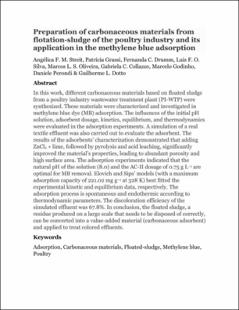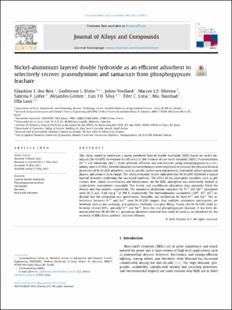Buscar
Mostrando ítems 41-50 de 70
Preparation of activated carbon from the residues of the mushroom (Agaricus bisporus) production chain for the adsorption of the 2,4-dichlorophenoxyacetic herbicide
(Corporación Universidad de la Costa, 2021)
The production of the edible mushroom Agaricus bisporus occurs on a world scale, where tons are constantly produced. At the same time, this production generates a large amount of waste that needs to be adequately conditioned. ...
Adsorption of atrazine herbicide from water by diospyros kaki fruit waste activated carbon
(Elsevier, 2021-11-10)
In this work, Diospyros kaki fruit waste was employed as a precursor material to develop a high surface area activated carbon, which efficiently removed the toxic herbicide atrazine (ATZ) from synthetic water solutions and ...
Adsorbents for glyphosate removal in contaminated waters: a review
(2020-10-26)
Glyphosate is an herbicide used to control weeds and optimize agricultural production. However, since glyphosate is an emerging pollutant claimed to be potentially carcinogenic, glyphosate pollution of soils and water is ...
Investigation of biochar from Cedrella fissilis applied to the adsorption of atrazine herbicide from an aqueous medium
(Elsevier BV, 2022)
Biochar was produced from the sawdust of the wood forest species Cedrella fissilis and later used as an adsorbent to remove atrazine herbicide from aqueous media. Biochar showed high thermal stability, an amorphous structure, ...
Preparation of carbonaceous materials from flotation-sludge of the poultry industry and its application in the methylene blue adsorption
(Springer Science + Business Media, 2023)
In this work, different carbonaceous materials based on floated sludge from a poultry industry wastewater treatment plant (PI-WTP) were synthesized. These materials were characterized and investigated in methylene blue dye ...
Nickel-aluminium layered double hydroxide as an efficient adsorbent to selectively recover praseodymium and samarium from phosphogypsum leachate
(Elsevier BV, 2023-10-15)
This study aimed to synthesize a green powdered layered double hydroxide (LDH) based on nickel-aluminum (Ni–Al-LDH) to evaluate its efficiency in the removal of rare earth elements (REEs), Praseodymium (Pr3+) and Samarium ...
Adsorptive potential of Zn–Al and Mg–Fe layered double hydroxides for the removal of 2–nitrophenol from aqueous solutions
(Universidad de la Costa, 2020-08)
Two layered double hydroxides (LDH) of the type Zn–Al and Mg–Fe were synthesized, characterized and used as adsorbents to uptake 2–nitrophenol (2–NP) from aqueous solutions. XRD, FTIR, SEM, EDS, AFM and N2 adsorption/desorption ...
An eco-friendly and low-cost strategy for groundwater defluorination: adsorption of fluoride onto calcinated sludge
(Corporación Universidad de la Costa, 2020-09-28)
The excess of fluoride ions (F−) in water for human supply is a serious public health. The recommended concentration of F− ions by the World Health Organization (WHO) is 1.5 mg L-1. Several groundwater sources around the ...
Preparation of alumina-supported Fe-Al-La composite for fluoride removal from an aqueous matrix
(Springer Science + Business Media, 2023)
Using groundwater for human consumption is an alternative for places with
no nearby surface water resources. Fluoride is commonly found in
groundwater, and the consumption of this water for a prolonged time in
concentrations ...
Degradation of diclofenac aqueous solutions in a 3D electrolytic reactor using carbon-based materials as pseudo third electrodes in fluidized bed, anodic and cathodic configurations
(Elsevier BV, 2022)
In this study, the degradation of diclofenac (DCF) in a 3D electrochemical reactor was evaluated. Several parameters were studied including the reactor configuration: fluidized bed (FB), anodic packed bed (APB) and cathodic ...










